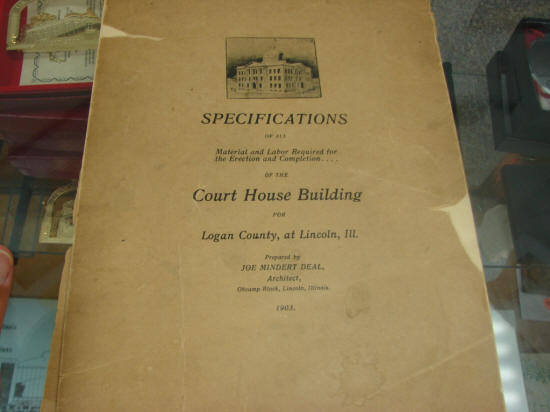|
Farmer focused on the many political boundaries that
make up the county. One might think there are contiguous towns and
cities in one county, but that is not the case. Logan County is made
up of much more than that.

Diane Farmer highlights the few counties that existed in Illinois
when it became a state in 1818. The rest of the counties were added
over the next few decades, including Logan County in 1839.
Illinois was founded in 1818, and the outline of the
state was set at that time. But, the final internal boundaries of
the state, the counties, were not laid out until many years later.
In 1818, a few counties existed in southern Illinois. “Logan County
was not laid out until 1839 due to the efforts of a little known
member of the Illinois General Assembly, Abraham Lincoln,” said
Diane Farmer. Logan County was mostly carved out of part of Sangamon
County, which was then the largest county in Illinois by area, and
still is.

“When the boundaries of Logan County are viewed, a question that
comes to mind is why wasn’t it just made into a rectangle, why the
steps on the south and southwest side,” said Farmer.
Well, it seems that some of the landowners on the proposed borders
wanted to stay in Sangamon County and some wanted to migrate to the
newly designed Logan County. Abraham Lincoln had to satisfy all of
his wealthy landowning constituents, so he went to work moving
county borders here and there to satisfy these voters. The result is
a sort of zigzag.
Once the county was formed, Abraham Lincoln proposed to name it
after his friend in the Illinois General Assembly that was then
meeting in Vandalia. “Dr. John Logan of Murphysboro received the
honor of having a county named after him,” she said. Did Dr. Logan
ever visit the county before it was subdivided from Sangamon County?
Probably not, but politics and friendship ruled the day.

The boundary of Logan
County and the 17 townships included within it. Abraham Lincoln was
instrumental in founding Logan County and determining its
boundaries.
As Logan County continued to develop, further
divisions were drawn within it. These became known as townships.
Eventually seventeen townships were created each with its own
governing unit. Now there was a county government and a subset of
political entities called townships. Each township eventually was
governed by seven elected officials, four trustees, a clerk,
supervisor, and the road and bridge commissioner. The township has
taxing authority. The road and bridge commissioner has separate
taxing authority. Check your latest property tax statement and you
will see the two entities listed.
“The next divisions within Logan County were the
towns and villages,” said Diane. These again had their own taxing
and governing authority, sometimes overlapping the townships and
county. Once the county was formed, a county seat had to be
selected, the center of political power within the county.

The original Postville Courthouse served as the county seat for
Logan County from 1839 to 1847. After it was no longer used as a
courthouse, it was a grocery store and private residence, among
other uses. It was sold in 1929 to Henry Ford, disassembled, and
moved to a museum in Michigan. The courthouse was on the Eighth
Judicial Circuit that Mr. Lincoln rode during his days as a
traveling lawyer. A replica of the Postville Courthouse was built on
the site in 1953.
The first county seat was Postville, a small village
in the center of the county. A courthouse was constructed, used for
government purposes, and abandoned when the county seat was moved to
Mount Pulaski.
[to top of second column] |


Mount Pulaski was the county seat from 1847 until 1853. This
courthouse still stands and is considered an historic structure. Mr.
Lincoln practiced law in its courtrooms.
A courthouse was constructed in Mount Pulaski to
house the offices of county government and courtrooms.
Then the town of Lincoln was founded in 1853 by Mr. Lincoln and his
friends, and the county seat was moved to Lincoln.

The second Logan County Courthouse in Lincoln served from 1858 until
1903 on the site of the current courthouse. The first Logan County
Courthouse in Lincoln burned down in 1847. No renderings of it
remain.

The current and third Logan County Courthouse is represented on a
brochure during construction in 1903. It took several votes of the
electorate to get permission to build it. Most people were opposed
to its construction.

Construction specifications for the current Logan County Courthouse
in Lincoln are part of the Genealogical Society’s collection. A
Lincoln architectural firm designed it.
A courthouse was built to house county offices and
courtrooms in Lincoln. Then, it burned down. A second Logan County
courthouse was built in Lincoln, Lincoln now the permanent county
seat as it turned out. That courthouse lasted until the first decade
of the twentieth century, when a third courthouse was built in
downtown Lincoln. It still stands.

There is more. Remember the towns and villages that were built
within the boundaries of Logan County with their own borders? Well,
some of them went on to thrive and some disappeared into the mists
of time. “Fogarty, Bell, Evans, Harness, Mount Joy and others have
disappeared,” said Farmer. Do you know where they were located?
Logan County has a rich history. Diane Farmer knows all about it,
and her presentation was a view into olden times that began only a
few years after the founding of the United States, and Illinois.
The Logan County Genealogical and Historical Society meets the third
Monday of the month at 6:30 p.m. at their collection and research
facility across the street from the newly renovated Lincoln Depot.
Visitors are welcome, and there is always an interesting
presentation.
[Curtis Fox]
 |